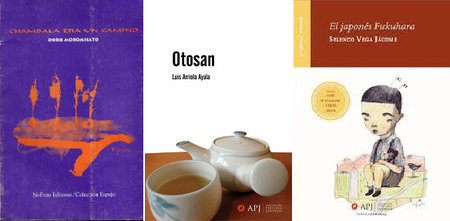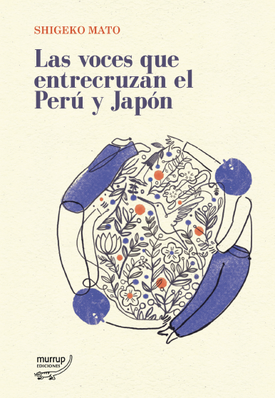Geographic distance has not been a reason to separate the literary creation of two countries as dissimilar as Peru and Japan, whose real stories have fueled those of fiction. Writers and academics have looked at the crossed paths of these nations, finding themes, coincidences and other curiosities from migration.
Japanese professor Shigeko Mato is a student of both literatures and has specialized in analyzing their subtle encounters. She says that her professors at the University of New Mexico, in the United States, encouraged her to read literary works from Latin America, so that she could improve her Spanish. “In high school in Japan, I didn't have much passion for literature because the way of reading was very mechanical and there was no opportunity to express my ideas.”
When he read The Death of Artemio Cruz , by Carlos Fuentes, he fell in love with its complexity; he says it was “as if he participated in the process of making the work together with the protagonist, the narrator and the author.” From that interest he jumped to other authors of the Latin American boom and from there to Nikkei literature, although he questions his name.
“In a Spanish language course, we read a story about a relationship between a grandmother, a Japanese immigrant, and her grandson born in a Hispanic American country. I don't remember much of the details of the story, but I remember the feeling of surprise that I had when I found a relationship between Latin America and my country."
Getting to know Nikkei
In Peru, the main references of Nikkei literature are very dissimilar: José Watanabe, Augusto Higa, Fernando Iwasaki, Doris Moromisato, Carlos Yushimito. Shigeko says that Watanabe is her favorite poet. “Like Arguedas, Wanatabe's poetry traps the reader in his homeland of Laredo, where there is much contact with nature and where there seems to be no division between the human and natural worlds. Write poems to talk about everyday things observed in a natural way without any pretension of creating a magnificent poem.”
De Higa was interested in how he inserts different voices into the stereotypes of Japanese descendants. “I am especially interested in its protagonists who are almost always outside the circle of the Nikkei community, revealing what has been hidden.” She considers that the great contribution of these writers has been to have opened a door to give another look at Japanese culture and identity in Peru and Latin America.
"I don't want to associate them only by their race, ethnicity or last name, but Japanese words appear in their works and it cannot be denied that they want to show something that is related to Japan, at least." Shigeko refers as an example to Higa's narration of his experience as a dekasegi in Japanese lands. “He is a generous and patient writer,” he says of Augusto, whom he was able to interview about how he decided to include Nikkei in his works.
written voices
The voices that intersect Peru and Japan is the book that Shigeko published this year with the Morrup publishing house, with which he approaches different works to review the term “Nikkei literature.” She questions the use of this category and notes that she does not believe in a Japanese side and a Peruvian side. “For me they are writers of Japanese descent who incorporate something Japanese into their works. There are Peruvian writers who also incorporate something related to Japan or Japanese memory in Peru, such as Selenco Vega Jácome.”
Other Peruvian authors, such as Luis Arriola, have narrated the migration, but from Peru to Japan, in books such as Gambate and the stories of Otosan . In the case of Diego Alonso Sánchez Barreto, he has explored the Japanese technique of haiku in the books of poems By the small inner path by Matsuo Basho and A path begins without knowing it . The novelist Enrique Planas has also drawn on the Japanese culture and presence in Peru in his novel KimoKawaii .
For Shigeko Mato, there is a less addressed topic regarding the links between Peruvian and Japanese literature and that is what refers to the government of Alberto Fujimori. “I would love to see the issue of Fujimorism from the perspective of the Nikkei community. Another topic that interests me is the dekasegi experience of Nikkei and non-Nikkei Peruvians,” says the researcher. Without a doubt, this vision could contribute to addressing the xenophobia so present in Peru.

Language and identity
Much of the literature that addresses the life of migrants or Japanese descendants in Peru has to do with identity. From there, works have emerged that the researcher considers positive because they have allowed the introduction of an entire thematic space of the Nikkei in Peruvian literature, but they have also been negative because they limit these works to that category, when there are Nikkei writers who have told other types of stories. stories.
There may be Fernando Iwasaki and Carlos Yushimito, for example, who have included references from Spain and Brazil in their stories. “Now I'm thinking about doing a comparative project on the connections between Nikkei memory and other memories in Peru, Latin America and Asia,” says Shigeko. “I first want to explore the small memories that have not been visible in the world and examine what points of intersections (nodes and assemblages) they create when one memory encounters the other.”
In The voices that intersect Peru and Japan, migratory memory is addressed through the work of the Peruvian writer Doris Moromisato; the multiplicity of identity in the novel Mezameyo to ningyo wa utau ( Wake up, sing siren ), by Tomoyuki Hoshino; the dekasegi phenomenon and undocumented migrants in “Lolo”, by Luis Arriola; and the silenced memories in Peruvian society and the Nikkei community in The Japanese Fukuhara , by Selenco Vega.

© 2021 Javier Garc;ia Wong-Kit






